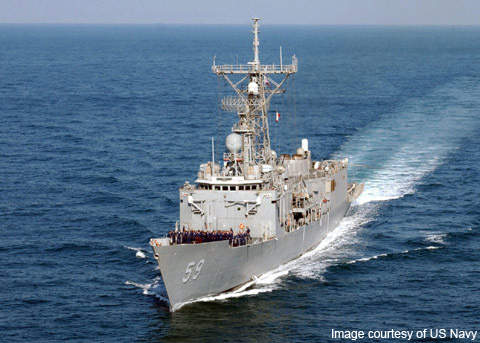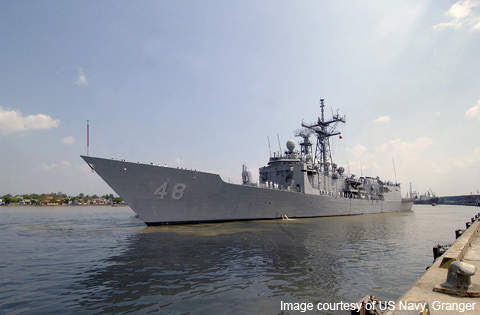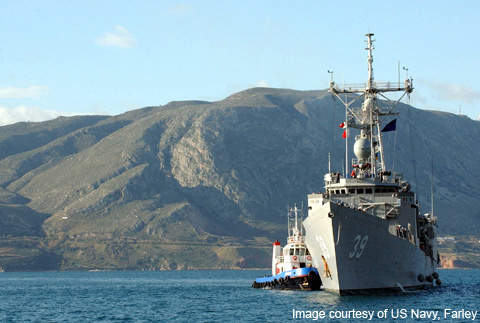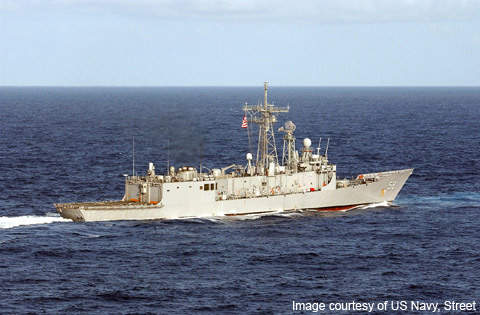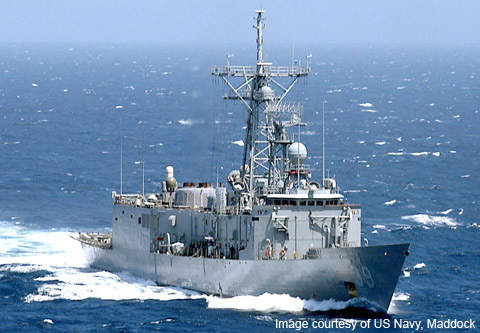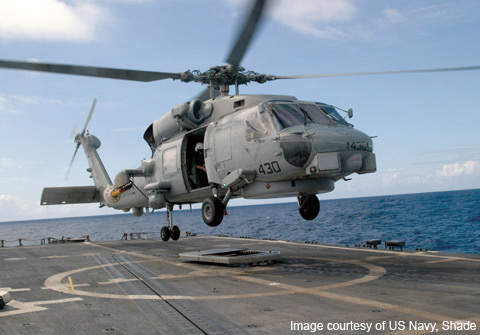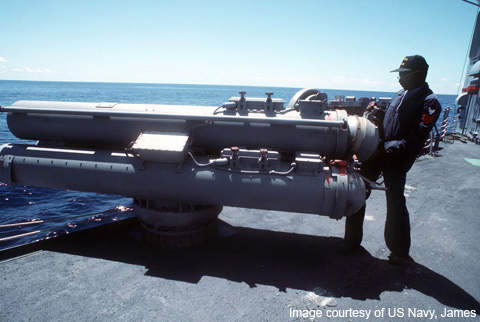The US Navy has 29 Oliver Hazard Perry Class guided missile frigates remaining in service of the 50 built for the US Navy during the 1970s and 1980s. The frigates have a full load displacement of 4,100t. The maximum speed is 30kt and the range at an economical speed is 4,500nm.
The frigates were built by Bath Iron Works (24) in Maine and Todd Shipyards (29) in Seattle and San Pedro, California. Oliver Hazard Perry (FFG 7) entered service in December 1977. The last USN vessel, USS Ingraham (FFG 61) was commissioned in August 1989.
Oliver Hazard Perry Class international variants
The Australian Adelaide Class frigates are based on the Oliver Hazard Perry Class. Four ships (FFG 17, 18, 35 and 44) were built for Australia in the USA, two more were constructed in Australia. Australia ordered an additional two new Perry Class ships built by the Williamstown Naval Dockyard (now part of Tenix Defence) – HMAS Melbourne (FFG 05) commissioned in 1992 and HMAS Newcastle (FFG 05) commissioned in 1993.
Six Santa Maria Class frigates built by Bazan (now Navantia) for the Spanish Navy and eight Chen Kung class built by China SB for Taiwan were built to the Perry Class design.
A number of ships have been decommissioned and transferred to other countries: Bahrain (one), Egypt (four), Poland (two) and Turkey (nine).
In October 2008, the US Government approved the transfer of USS McInerney (FFG-8) to the Pakistani Navy. The USS McInerney was formally transferred to Pakistan in August 2010. Renamed PNS Alamgir, the frigate underwent a major seven-month overhaul at BAE Southeast shipyards. In March 2011, it sailed to Pakistan to join the Pakistani Navy Maritime Patrol (MARPAT) mission.
Command and control
The frigates’ combat data system is the naval tactical data system (NTDS).
The Perry Class weapon control system is the Mark 92 FCS which provides X-band radar surveillance integrated with target tracking and fire control for the guns and missile systems. Lockheed Martin is the design agent for the mk92 FCS which is a US derivative of the Thales Netherlands Signaal WM28 fire control system.
Guns
The ship’s main gun is the Oto Melara mk75, 76mm naval gun which fires 6kg anti-aircraft shells to a range of 12km and anti-surface ship rounds to 16km.
The close-in-weapon system is the Raytheon mk15 block 1B Phalanx six-barrel 20mm gun. The CIWS fires 4,500 rounds a minute to a range of 1.5km. Phalanx provides short-range defence against surface and airborne incoming threats including high-speed surface craft.
The ships carry four general-purpose 12.7mm machine guns and can be fitted with 25mm mk38 guns supplied by Boeing.
Missiles
The US ships’ surface-to-air and surface-to-surface missiles were removed in 2004 but the ship supports Penguin-missile-armed LAMPS III helicopters.
Other nations’ Perry Class frigates retain the missile system capability with the Boeing Harpoon surface-to-surface missiles and Raytheon Standard SM-1MR surface-to-air missiles.
Torpedoes
Torpedoes are fired from two deck-mounted mk32 triple-tube torpedo tubes. The ship’s torpedoes are the Alliant Techsystems (ATK) mk46 mod 5 lightweight anti-submarine torpedoes and the ATK mk50 torpedo.
The mk46 mod 5 has a range of 11km. The torpedo is armed with a 44kg warhead and uses passive and active homing to approach the target at a speed of 40kt.
The mk50 torpedo is armed with a 45kg shaped charge warhead and has a range of 15km. The torpedo uses active and passive homing and has a speed of 50kt.
Aircraft
The ship accommodates two Sikorsky SH-60B LAMPS III Seahawk helicopters. The ship has two hangars and a 410m² helicopter deck fitted with a single landing spot and a RAST recovery assist securing and traversing system. The ship is equipped to support LAMPS (light airborne multipurpose system) missions.
The ship’s AN/URN-25 TACAN tactical air navigation transponder provides aircraft with data on range, bearing and identification. The IFF interrogator is the mkXII AIMS UPX-29.
The SH-60B LAMPS mkIII helicopter has all weather capability for point defence against submarines and surface ships, and can also carry out fleet support, vertical replenishment, search and rescue and medical evacuation.
Countermeasures
The Perry Class frigates have two deck-mounted six-barrelled SRBOC mk36 decoy dispensers. The Lockheed Martin Sippican super rapid bloom offboard countermeasures SRBOC mk36 launches infrared and chaff flares to counter electro-optically and radar guided missiles and fire control systems.
The Perry Class is also fitted with the BAE Systems Australia mk53 Nulka active expendable decoys for protection against radar-guided anti-ship missiles. Nulka is rocket-propelled and operates over a broad radio band.
The torpedo decoys are the older T-Mk 6 Fanfare towed decoy or the Argon ST SLQ-25 Nixie towed decoy.
The Perry Class frigates are equipped with the Raytheon SLQ-32(V)2 radar warning and jamming electronic warfare system. The AN/SLQ-32(V) detects hostile radar emissions and analyses the pulse repetition rate, scan mode, scan period, and frequency. The system identifies the threat and direction, provides a warning signal, interfaces to the ship’s countermeasures systems and jams the hostile radar systems.
Sensors
The ship’s radar suite includes the Raytheon SPS-49(V)5 or (V)4 air search radar which operates over C and D bands. The radar detects aircraft to a range of 460km. The surface search radar is the ISC Cardion SPS-55 radar operating at I-band.
The Oto Melara mk75 gun is linked to the Sperry 92 fire control radar operating at I and J bands. The Furuno navigation radar also operates at I band.
Sonar
The ship is fitted with a AN/SQQ-89 (CV)2 anti-submarine warfare (ASW) combat system. The system integrates a Raytheon SQS-56 active and passive hull-mounted sonar and a Gould SQR-19 towed sonar array. The system displays the data from the sonar suite and from the helicopter LAMPS sensors and provides detection, classification, designation and targeting of submarines.
Propulsion
The propulsion system is based on two GE LM 2500 gas turbine engines generating 30.59MW (41,000shp) and driving a single shaft with a constant pitch propeller. There are two auxiliary retractable propellers (484kW / 650hp) for manoeuvring and station keeping.

